
A Dictionary of the Fuchsia™
Want to know what those mysterious terms mean and just who the people were behind those names? Then this is the place for you.
Want to know what those mysterious terms mean and just who the people were behind those names? Then this is the place for you.
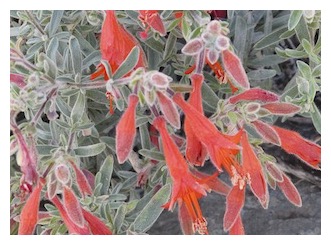
(Illustration: Epilobium canum ssp. canum.)
California Fuchsia Society – Defunct. See National Fuchsia Society.
Calyx – (Pl. calyces or calyxes.) The outer part of the flower that consists of the tube and sepals taken as a unit.
Campii – From fields or pastures; growing in open, even or flat areas. See F. campii (Berry 1995) in ➤ Section Fuchsia. There are no synonyms recorded of this species.
Campos de altitude – From the Portuguese for "high country or countryside." An ecological climate zone occurring generally in the Tropics, especially in South America and Africa, at an altitude above 1,200 meters (4,000 feet) and characterized by an open vegetation of natural fields of grasses and generally trailing woody plants or shrubs. The terrain is often rocky. The average temperatures of the campos de altitude are below 10° C (50° F) and they are subject to freezes and snow. The classic examples, from which the zone type derives its name, are areas such as the Pico da Bandeira and Pico das Agulhas Negras in Brazil. Other examples include Mount Kilimanjaro in Africa. Several members of Fuchsia sect. Quelusia are native to the campos de altitude of south-eastern Brazil and are among the most winter-hardy species in the genus. See ➤ Section Quelusia.

(Illustration: F. campos-portoi.)
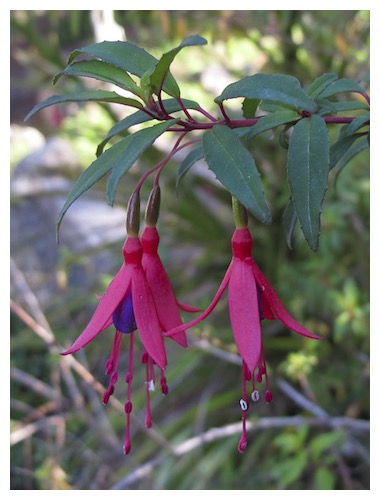
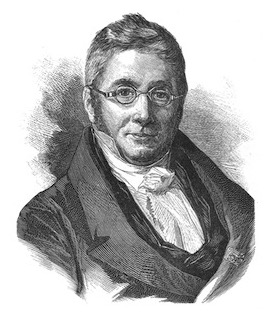
(Illustration: Portrait of A. P. de Candolle by Jules Pizzetta, Galerie des naturalistes: Histoires des sciences naturelles, 1894.)
Canescens – Having grey hair, greyish. See F. canescens (Benth. 1845) in ➤ Section Fuchsia. There are no synonyms recorded of this species.
Cape Fuchsia – Not a true fuchsia at all, but a common name for the only two Phygellis species and their crosses. Often confused with true fuchsias, Phygellis is in the Snapdragon Family and native to South Africa. See ➤ Faux Fuchsias entry; as well as ➤ Faux Fuchsias page.
Caracasana – From Caracas in Venezuela. F. caracasana (Fielding & Gardner 1844) is a synonym of F. hirtella (Kunth 1823) in ➤ Section Fuchsia. The perhaps identical species designation F. caracasensis (Fielding & Gardner 1844) is also invalid but remains unresolved as a synonym.
Caracasensis – From Caracas in Venzuela. See Caracasana above.
Caranquii – Named for an Ecuadoran botanist and plant collector, Jorge Caranqui Aldaz (b. 1972) who published a short paper on fuchsias in Ecuador entitled Observaciones sobre Taxonomía y Propogacíon en el Ecuador del Género Fuchsia in 2002 and, later, an article on taxonomic and propagation advances of the genus Fuchsia in Ecuador (2011). F. x caranquii does not seem to be accepted as a formally published taxon, however, and apparently refers to a naturally occurring hybrid between F. scherffiana and F. steyermarkii.
Carotenes, Carotenoids – A group of compounds and pigments that give the yellow-orange to red colors found in many plants.
Carpel – The female reproductive parts of a flower consisting of the ovary, style and stigma.
Caspid Bug – Various species within the Miridae, especially Lygocoris, Lygus and Plesiocoris. These small insects can cause a considerable amount of disfiguring damage to growing fuchsias. Capsid bugs suck sap, especially from the tips of shoots, through boreholes that cause the surrounding plant tissue to die. Consequently small holes and characteristic "tears" appear and disfigure the leaves as they grow. Flowering can be significantly delayed as new growth has to develop in compensation. Systemic insecticides and insecticidal soaps are both effective when applied at the first sign of caspid bug damage.
Caucana – From Cauca Province in Colombia. See F. caucana (Berry 1982) in ➤ Section Fuchsia. There are no synonyms recorded of this species.
Cauliflory – The production of flowers on the trunk of a plant. The corresponding condition of flowers on the branches is termed ramiiflory.
Ceracea – Waxy. See F. ceracea (Berry 1982) in ➤ Section Fuchsia. There are no synonyms recorded of this species.
Cestroides – Resembling Cestrum, or jessamine. See F. cestroides (Schulze-Menz 1940) in ➤ Section Hemsleyella. There are no synonyms of this species recorded.
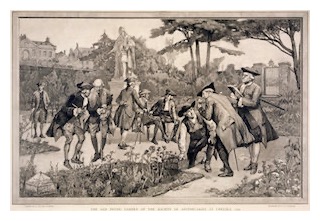
Under the direction of the celebrated botanist, Philip Miller (1691–1771; see also), Chelsea was to became one of the world's most renowned botanic gardens and its collection was certainly unsurpassed during his tenure as head gardener. A seed exchange with the Dutch was already established at Chelsea by 1682 and seeds have continued to be exchanged from around the world until the present day. One of this exchange's most notable and far-reaching effects was the introduction of many American plants and trees, sent by the Pennsylvania botanist John Bartram, into the British landscape. "Bartram's Boxes" arrived in annual shipments and were doled out to subscribers through Miller's intermediacy. This American trade continued for a number of years after Miller's death.
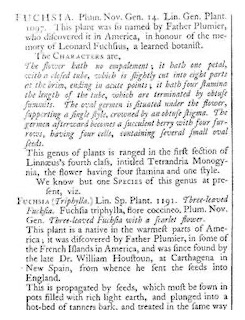
Miller himself had a reputation as an unrivaled horticulturalist who could get anything to grow and was the grower of many of the exotic seeds and plants that came into Chelsea. About 1730, he received the seeds of a fuchsia shipped from "Carthagena in New Spain" (Cartagena de Indias is on the Caribbean coast of Colombia and was then the capital of New Granada, not New Spain) from fellow Scotsman and botanist William Houstoun (see also). This fuchsia, identified as F. triphylla (see also), was apparently successfully grown for a number of years before disappearing from cultivation at some point.
Since Miller was head gardener from 1722 to 1771, it's unclear at what date this fuchsia was lost. Unfortunately, no preserved specimen of the plant has survived, if any was ever taken. There is also some possibility that this fuchsia might actually have been a species closely related to F. triphylla, such as F. nigricans, due to the fact that Houstoun botanized in that area of South America and not Hispaniola.
(Illustration: 1. Henry Gillard Glindoni (1852-1913), engraved by Thomas W. Lascelles (d. 1914), Old Physic Garden of the Society of the Apothecaries at Chelsea, 1750, 1890; 2. Detail of the entry on Fuchsia, Philip Miller, The Gardeners Dictionary, 8th Edition, 1768.)
Chiapensis – From the state of Chiapas in Mexico. See F. microphylla subsp chiapensis in ➤ Section Encliandra of which F. chiapensis (Bradegee 1944) is a synonym.
Chilca – See Chilco directly below.
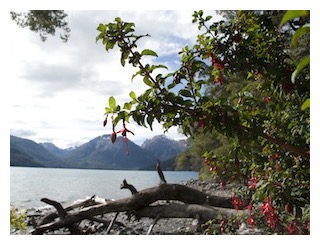
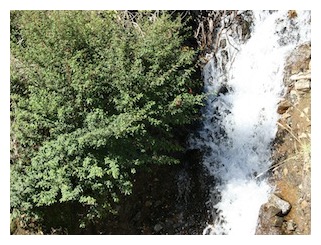
See ➤ Common Names, For additional common names specifically in Spanish, see also ➤ Aljaba, ➤ Corales, ➤ Coralitos, ➤ Pendientes de la Reina.
(Illustration: 1. F. magellanica at the Arroyo Chilco on the shore of Lago Moscardi in the Patagonian Lake District of the Argentine Andes; 2. Growing along the side of a steep stream draining into the same lake.)
Chilcón – See Chilco directly above.
Chirco – See Chilco directly above.
Chloroloba – Having green lobes. See F. chloroloba (I.M.Johnst 1939) in ➤ Section Hemsleyella. No synonyms of this species are recorded.
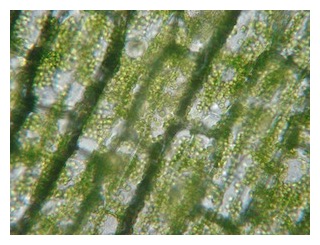
(Illustration: Chlorophyll in the ➤ chloroplasts of plants cells.)
Chloroplasts – Organelles in a plant's leaves in which ➤ photosynthesis occurs.
Chonotica – F. chonotica (Phil 1856) and F. coccinea var. chonotica (Phil.) Reiche 1897) are both synonyms of F. magellanica (Lam. 1788) in ➤ Section Quelusia.
Chromosomes – Very long, thread-like bodies that occur in the nuclei of all cells. Individual genes located on the chromosomes contain the genetic code for any organism's particular characteristics. In fuchsias, an awareness of chromosomes is very important to targeted hybrid breeding programs. Fuchsia chromosomes are large and heterogeneously sized for the Onagraceae family. They're always present in multiples of eleven (n = 11) and large double-flowered hybrids may achieve chromosomal counts of seven times the base, or more. Most sections in the genus are entirely diploid (n = 11), two are mostly diploid and two, Sections Quelusia and Kierschlegeria, are entirely polyploid, with some natural tetraploid (n = 22) or octoploid (n = 44) population areas occurring within F. regia.
Ciliate – Having an outer layer or margin edged with cilia or short hairs.
Cinnabarina – Cinnabar red. F. × cinnabarina (D.C.McClint.1950) is a synonym of F. × bacillaris (Lindl. 1832) in ➤ Section Encliandra.
Cinerea, Cinereous – Ash colored. See F. cinerea (P.E. Berry 1982) in ➤ Section Fuchsia. No synonyms of this species are recorded.
Circaea – A genus in the Onagraceae family consisting of about seven to ten species. Known as enchanter's nightshade, Circaea L. was named for the minor goddess of magic, Circe, who supposedly used it in her spells. They are woodland plants occurring throughout temperate regions in the Northern Hemisphere. Within the Onagraceae family (see also), this genus is the one most closely related to Fuchsia, with which it shares a position in the Circeeae tribe of the Onagroideae subfamily. Recent DNA analyses indicate that the two genera split from the same mother genus Circaea+Fuchsia about forty-one million years ago. See ➤ History of the Fuchsia.
Circaeeae – The tribe within the Onagroideae subfamily of the Onagraceae family (see also) that contains the genus Fuchsia. Its only other member is Circaea, the species most closely related to Fuchsia.
Cloud forest – A tropical or subtropical moist, evergreen forest generally located at or near the peaks of coastal mountains and characterized by frequent or persistent low-level cloud cover, especially at its canopy level. Also known as "fog forest" as much of its moisture might come by way of condensation dripping down from the canopy.
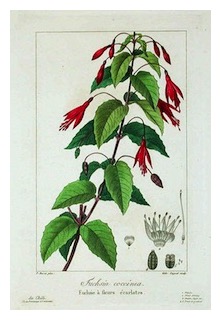
(Illustration: F. coccinea, La Flore des Jardiniers Amateurs et Manufacturiers, 1836.)
Cochabambana – From Cochabamba Province in Bolivia. See F. cochabambana (Berry 1982) in ➤ Section Fuchsia. No synonyms of this species are recorded.

Colenso caused something of a scandal—and put his hoped-for religious ordination pretty much on permanent hold—when it was discovered that he had fathered a son, Wiremu (William) with his wife's Maori maid, Ripeka, in 1851. Subsequently he spent several years botanizing in the "wilderness" but was apparently forgiven by New Zealand’s nascent society. He was later elected a member of parliament for Napier from 1861-1866.
Because of the several books and numerous articles he authored, he was the first resident of New Zealand to be elected to the Royal Society in London in 1866. In response to the bicentenary of his birth, the Colenso Society was formed in 2010 to promote his life and work. Not inappropriately, it seems, the fuchsia species name in his honor, F. colensoi, is now considered a natural hybrid between F. excorticata and F. perscandens.
See ➤ Section Skinnera.
Colensoi – Named in honor of William Colenso (1811-1899). F. x colensoi (Hook 1847) is now considered a natural hybrid between F. excorticata and F. perscandens. See: Colenso; F. x colensoi in ➤ Section Skinnera.
Colimae – From or belonging to the state of Colima in Mexico. F. colimae (Munz 1943) is a synonym of F. thymifolia (Kunth 1823) in ➤ Section Encliandra.

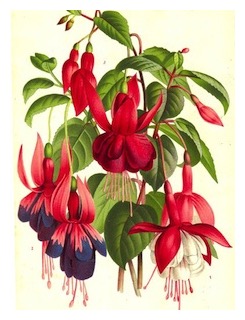
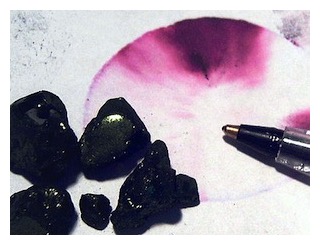
See The Urban Fuchsia + Blog ➤ The Color Fuchsia for an expanded essay on the color.
(Illustrations: 1. Two ladies in walking dresses, Paris, 1896; 2. Fuchsias Nouveux, Revue de l'Horticulture Belge et Étrangère, 1876; 3. Fuchsine crystals and stain, ➤ Wikipedia.)
Colombiana – From Colombia. F. colombiana (Munz 1946) is a synonym of F. corollata (Benth. 1845) in ➤ Section Fuchsia.
Column – A specimen fuchsia that has been trained into a tall pillar shape with straight sides. One method of training is to select a vigorous upright stem to be grown to the desired height. The tip is removed and side shots are all pinched back uniformly to two or three sets of leaves. Further side shoots are again pinched back uniformly to two or three sets of leaves. The process is repeated until the desired width and density are reached. See also ➤ Biennial Method, ➤ Cone, ➤ Pyramid.
Comestibilty – See Berries, Edibility, Recipes; See also ➤ Fuchsia Recipes.
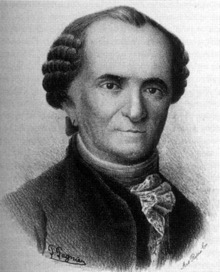
Common Names – The kotukutuku, F. excorticata or the tree fuchsia of New Zealand, is an example of an old native name that’s been adapted locally into English. Other names are really just translations of the Latin species epithet into English to make the plant more accessible to general readers. The “Small-leaf Fuchsia,” F. microphylla, or the “Scarlet Fuchsia,” F. coccinea, which dates as one of the earliest species introduced into cultivation, are two such examples. A number of so-called common names are listed in this Dictionary but with the caveat that their general usage, especially in English, is anything but common and is mostly restricted to repetition in reference works. See ➤ Lady's Eardrops.
Cone – A specimen fuchsia that has been trained into a tall pointed shape with a narrow base. An upright stem is selected and grown to about two feet. The tip is then removed and side shots are allowed to develop and then stopped at two or three sets or leaves. The top shoot, however, is grown on for another two feet before it's stopped, along again with the previously stopped side shoots on the lower level. The process is repeated until the desired height is reached and will usually take two years to create a large-sized specimen. A similar shape, the pyramid, is considered to have a wider base. The two shapes are more or less identical, however. See also ➤ Biennial Method, ➤ Column, ➤ Pyramid.
Confertifolia – Densely leaved. See F. confertifolia (Fielding & Gardner 1844) in ➤ Section Fuchsia. F. dolichantha (E.H.L.Krause 1905) is a synonym of this species.
Conica – Cone shaped. F. conica (Lindl. 1827) is a synonym of F. magellanica (Lam. 1788) in ➤ Section Quelusia.
Copper – A deficiency in the trace element copper may cause leaf drop. The condition is not common in fuchsias.
Coracifolia – Incorrect spelling of ➤ coriaceifolia.
Corales, coralitos – Common name for the fuchsia in some Spanish-speaking areas. Literally Corals or Little Corals in reference to the often bright, coral-like red of the flowers. ➤ Common Names.
Corallina – Coral red. F. × corallina (Lynch 1883) is a synonym of F. × exoniensis (Paxton 1843). Current botanical conventions specify that these garden names, which have no recognized taxonomic status as natural species or crosses, should be treated as cultivars: Fuchsia 'Corallina' and Fuchsia 'Exoniensis.'
Cordate – Heart-shaped. The term is applied to fuchsia leaves with this general outline.
Coriacifolia – Incorrect spelling of ➤ coriaceifolia.
Cordifolia – Having heart-shaped leaves. F. cordifolia (Benth 1841) is a synonym of F. splendens (Zucc 1832) in ➤ ;Section Ellobium.
Coriaceifolia – Leathery-leaved. See F. coriaceifolia (Berry 1982) in ➤ Section Fuchsia. Note: Due to a typographical error, the name of this then newly described species was incorrectly published as Fuchsia coracifolia [sic] in Paul E. Berry. Annals of the Missouri Botanical Garden, 1982, Vol. 69, p. 150. The inadvertent omission of an "i" after the first "a" was later corrected in Paul E. Berry. “Nomenclatural Changes in the Genus Fuchsia.” Annals of the Missouri Botanical Garden, 1988, Vol. 75, No. 3, p. 1150. Unfortunately, the corrected epithet itself contains a grammatical error and is misspelt as well. The Latin stems of coriacea + folia should have been joined as coriaceifolia, which is necessarily the correct spelling of the species despite the published nomenclatural change.
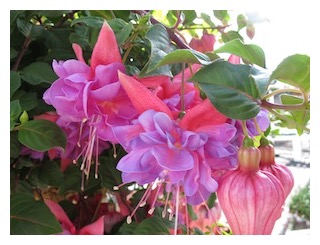
Corollata – Like a corolla. See F. corollata (Benth 1845) in ➤ Section Fuchsia. F. colombiana (Munz 1946) is a synonym of this species.
Correa reflexa – Not a true Fuchsia at all but often commonly described as the "Australian Fuchsia" or "Native Fuchsia." See ➤ Faux Fuchsias entry; as well as ➤ Faux Fuchsias page.
Corymb – A flat-topped or convex inflorescence in which the individual flower stalks grow upward from various points on the stem to all end at approximately the same height. The outer flowers of the corymb open first.
Corymbiflora – Flowering in corymbs (see also directly above). See F. corymbiflora (Ruis & Pav. 1802) in ➤ Section Fuchsia. F. corymbosa (Pritzel 1866), F. munzii (J.F.Macbr. 1941) and F. velutina (I.M.Johnst. 1925) are all synonyms of this species. F. corymbiflora var. alba (Harrison 1849) is a synonym of F. boliviana 'Alba' in ➤ Section Fuchsia. It represents a pale-flowered horticultural selection and is a mutation found only in cultivation or naturalized in areas where it has escaped from cultivation.
Corymbosa – Full of corymbs, or flat topped flower heads. F. corymbosa (Pritzel 1866) is a synonym of F. corymbiflora (Ruis & Pav. 1802) in ➤ Section Fuchsia.
Cosmopolitan – In botany, widely distributed and found growing in many parts of the globe. While some genera of the Onagraceae such as Ludwigia are cosmopolitan, Fuchsia has a more restricted range. Most species occurs from southern Mexico to the tip of South America, with a small handful of outliers on Hispaniola, New Zealand and Tahiti.
Crassate – Thick.
Crassistipula – Having thick ➤ stipules. See F. crassistipula (Berry 1982) in ➤ Section Fuchsia. No synonyms of this species are recorded.
Crenate – Edged with rounded teeth. Leaves, for example, might have a crenate margin.
Crocks – Crooks or other materials are often placed at the bottom of a pot to supposedly to aid in drainage. Recent studies have revealed that the long-standing technique is of no value and does not increase drainage. Crocks will, however, help weight down lighter pots and planters in areas where they are prone to blow over.
Croxteth Hall National Collection of Hardy Fuchsia Species & Cultivars – See ➤ National Collections (UK).

While still in Spain, Cuatrecasas had begun a publication on José Celestino Mutis' Flora Americana but that endeavor had to be abandoned when Francisco Franco took control of the country during the Civil War and the politically suspect Cuatrecasas was forced to flee into exile in Paris in 1939. That same year, he moved to Bogotá at the invitation of Colombia's president, Eduardo Santos.
Cuatrecasas had previously been in Colombia in 1932, when he was sent as Spain's official representative for the bicentenary of Mutis' birth, and he took part in his first expedition to the páramo in the Cordillera Central. He had returned again in 1938 when he conducted field trips to the Cordillera Oriental and the Llanos Orientales. The botany of Colombia would remain a life-long passion. When later based at the Smithsonian Institution, Cuatrecasas made ten separate collecting trips back to Colombia, as well as Venezuela. Although he also collected in a number of other countries, ninety-five
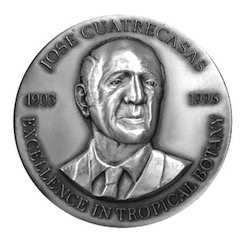
Cuatrecasas produced hundreds of publications in his lifetime and was the author of a great many taxa. His scientific passion was the Asteraceae, especially the genus Espeletia and his work focused on the high-elevation páramo and sub-páramo regions of the Andes, especially again on the Asteraceae and Malpighiaceae families. Cuatrecasas first collected the fuchsia that would later be described in his honor in Colombia in 1940 (Munz 1943).
In 1997, the Smithsonian Institution established the José Cuatrecasas Botanical Fund to support significant research projects that emulate the spirit of his research and also awards an annual José Cuatrecasas Medal for Excellence in Tropical Botany since 2001.
See F. cuatrecasasii in ➤ Section Fuchsia.
Cuatrecasasii – Named in honor of José Cuatrecasas Arumí (1903-1996). See: Cuatrecasas directly above; F. cuatrecasasii (Munz 1943) in ➤ Section Fuchsia. No synonyms of this species are recorded.
Cultigen – A plant that that have been deliberately modified or altered through artificial selection. See also Cultivar directly below.
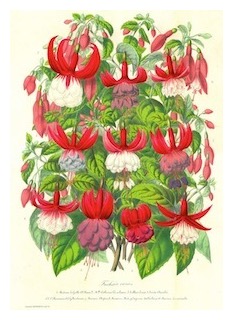
(Illustration: La Belgique Horticole, Annales d'Horticulture Belge et Étrangère, F. Detollenaere, 1863.)
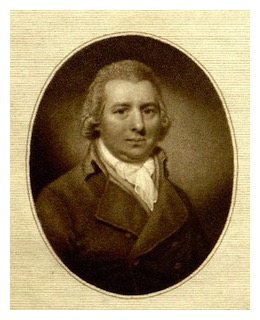
Starting in 1787, he published the first issue of his successful and influential reference work, The Botanical Magazine; or, Flower-Garden Displayed, which featured elegant hand-colored copper-engraved plates by a number of artists alongside a page or two of text describing that plant's features and history. The magazine was continued after Curtis's death and is still published by the Royal Botanic Gardens at Kew as Curtis's Botanical Magazine.
"Fuchsia Coccinea. Scarlet Fuchsia" appeared as No. 97 of Vol. 1 in 1794. The illustration of this fuchsia, done by Sydenham Edwards who produced most of the watercolors for the first volume, is both interesting and beautiful but seems to underscore the perplexing confusion between F. coccinea and F. magellanica at this early date. The leaves are characteristic of the latter, with its red veining, while the flowers tend more to the former. The plant stock for the drawing was apparently provided by James Lee's nursery. The text also seems to conflate the two. Fuchsia coccinea is indeed more tender but, since most all the so-called F. magellanica varieties grown today are actually hybrids, it's not inconceivable that the plant used for the illustration was already a cross between the two.
As Curtis's work was highly influential in introducing new plants to a wide audience both in Britain and the United States, it's well worth quoting the accompanying description in full:
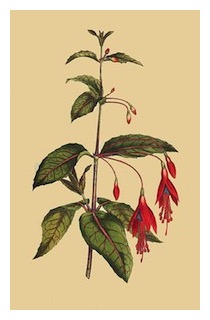
(Illustrations: Portrait of William Curtis and "Fuchsia Coccinea," The Botanical Magazine, 1794)
Curviflora – Having a curved flower. F. curviflora (Benth.1845) is a synonym of F. petiolaris (Kunth 1823) in ➤ Section Fuchsia.
Cuspidata – Sharply pointed. F. cuspidata (Fawc. & Rendle 1926) is a synonym of F. boliviana (Carrière 1876) in ➤ Section Fuchsia.
Cutting – A piece of a plant, such as the tip of a branch, that will be used to vegetatively propagate a new plant from the parent by rooting.
Cylindracea – A cylinder; cylindrical. F. cylindracea (Lindl. 1838) is a synonym of F. parviflora (Lindl. 1827) in ➤ Section Encliandra.
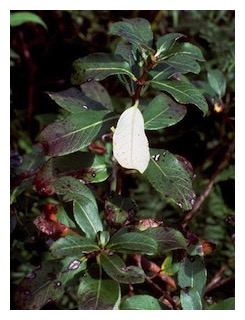
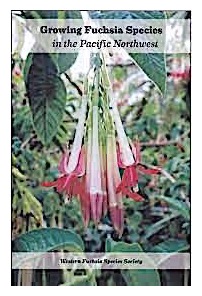
Damping off – The collapse or death of new cuttings or seedlings due to an attack by various kinds of fungi, reoften at soil level. Damping off mostly occurs under wet and cold conditions. Using sterile medium, providing some air circulation and keeping the soil somewhat drier can help prevent the spread of the disease. Spraying or drenching the soil with an anti-fungal treatment, such as copper oxychloride, also helps suppress the disease. The copper-based fungicide called Cheshunt compound, a mixture of copper sulfate and ammonium carbonate once widely used in the United Kingdom, is no longer legally used there (2011). Organic solutions, such as ones made from chamomile tea or garlic, are also used by some gardeners and are reported to be an effective treatment against the problem.
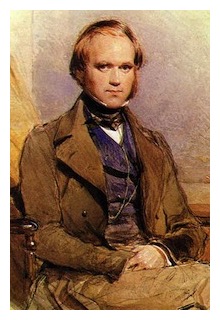
Despite the Beagle's rather routine warrant, the mission would prove to be historic for the profound influence it had on the young Darwin and the questions it raised in his curious mind. The ship returned to England via New Zealand, Tasmania and Australia. Darwin didn't rejoin the Beagle for its third mission to map the entire coast of Australia (1837-1843) but the crew might have missed him as they named Port Darwin in his honor. Or at least in honor of a new type of fine-grained sandstone found at Port Darwin that reminded them of him.
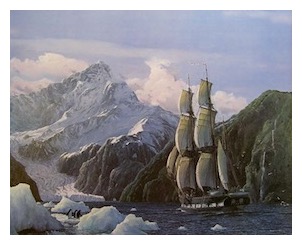
Later on December 18th of the same year, he recounted his own first personal brush with the fuchsia at Cabo Tres Montes when he "succeeded in reaching the summit of this hill. It was a laborious undertaking, for the sides were so steep, that in some parts it was necessary to use the trees as ladders: there were also several extensive brakes of the Fuchsia covered with its beautiful drooping flowers, but very difficult to crawl through."
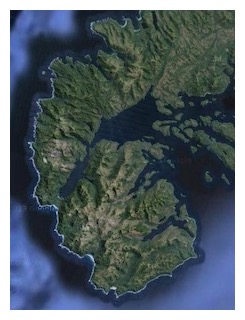
However, it is to Sir Joseph Dalton Hooker (see also), one of the greatest British botanists and explorers of the nineteenth century and next director of the Royal Botanical Gardens at Kew after his father from 1865 to 1885, that we seem to owe the sole record of Darwin's collection of Fuchsia. According to Porter, the younger Hooker ascribes "Fuchsia magellanica Lam. (Onagraceae). Prov. Aisén: Bahía San Andres, Península de Taito, 22 December 1834" to Darwin in The botany of the Antarctic voyage of H.M. discovery ships Erebus and Terror (1843-1847). The date and location make sense as this Fuchsia would have been collected by Darwin only days after his arduous climb to the top of a hill at Cabo Tres Montes through those difficult thickets of fuchsias.
Unfotunately, Porter doesn't provide a firm citation and the only reference to Darwin and the fuchsia in Hooker (1843-1847) is simply an abbreviated confirmation of habitat. Live specimens of some of the Chilean plants sent on by Darwin from Valdivia and Valparaíso were grown in the Cambridge Botanic Garden by Henslow from seed as well. It's not known if F. magellanica might have been among any of those Chilean plants raised by Henslow.
No other fuchsia species were noted by Darwin during the trip. F. magellanica is the only species, besides F. lycioides at the edge of the arid Atacama Desert of Chile, that comes down from the mountains to the coast on this side of South America so it's not surprising that Darwin seemed more distracted by the evolutionary possibilities of the finch than the fuchsia by the time the expedition reached the Galápagos Islands.
Darwin's take on F. lycioides might have been especially interesting if he had encountered it as the Beagle slowly made its way up the Pacific coast, as that species seems to be evolving into a thorny cactus in its harsh desert habitat. On the Atlantic coast of southern São Paulo and Paraná states, in mountainous southeastern Brazil, F. brevilobis does occur from 900 meters (3000 feet) down to sea level but the Beagle never made landfall in the area after stopping in Rio de Janeiro for supplies in 1832.
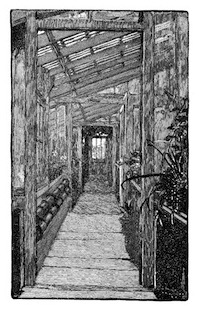
In the same work he quotes, "the remarkable case of a seed from Fuchsia coccinea fertilised by F. fulgens, which contained two embryos, and was 'a true vegetable twin.' The two plants produced from the two embryos were 'extremely different in appearance and character,' though both resembled other hybrids of the same parentage produced at the same time." Darwin seems more fascinated by this odd chimera as a freak of horticulture than as a normal plant and the remarkable number of differentiated fuchsia species hiding out in the Andes remain unnoticed.
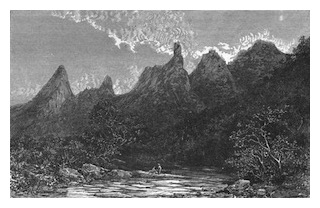
Darwin had himself only viewed these distant peaks, home of a number of fuchsias such as F. regia and F. alpestris, from the Beagle as it slowly passed down the coast of Brazil in 1832. He wondered "how any, ever so few, temperate forms reached the mountains of Brazil" and was now trying to understand what the evidence of these temperate-climate plants separated from their relatives in the Andes Mountains across "low intervening hot countries" might mean. As a route of dispersal and differentiation he supposed that they "traveled by the rather high land and ranges (name forgotten) which stretches from the Cordillera [Chilean-Argentinean Andes between 31° and 39° S latitude] towards Brazil. Cordillera genera of plants have also, somehow, reached the Silla of Caracas [in the Venezuelan Coastal Range of the Andes]." Scientists in this period, of course, were only beginning to understand the vast changes that have happened in the Earth's drifting geology, as well as the causes and effects of these changes on climate and plants.
For a brief summation of Fuchsia evolution and differentiation before and after Darwin, see ➤ History of the Fuchsia.
(Illustrations: 1. Portrait of Charles Darwin. George Richmond, 1840; 2. H.M.S Beagle 1832. Raymond Massey, 1832; 3. The rounded knob of the Cabo Tres Montes at the end of the Taitao Peninsula. The Bahía de San Andrés lies on the Pacific Ocean and is the indent in the upper western corner of the map; 4. Interior view of Darwin's greenhouses at Down House. "The Debt of Science to Darwin," The Century, Vol. 25, Issue 3 (January 1883); 5. The Organ Mountains in Brazil. Illustrated Travels: A Record of Discovery, Geography, and Adventure, London, 1880.)
Decidua – Deciduous; shedding or loosing leaves seasonally. See F. decidua (Standl. 1929) in ➤ Section Ellobium. No synonyms are recorded for this species.
Decumbent – Lying on the ground with tips turned upwards.
Decussata – Having leaves borne in pairs and held at right angles to each other; shaped like an X. See F. decussata (Ruiz & Pav. 1802) in ➤ Section Fuchsia. F. fusca (E.H.L.Krause 1906) and F. scandens (E.H.L.Krause 1905) are synonyms of this species.
Delirious with Fuchsias in the Garden – A poem by Vincent Silvertop. ➤ Delirious with Fuchsias in the Garden.
Denticulta – Finely toothed, especially the leaves. See F. denticulata (Ruiz & Pav. 1802) in ➤ Section Fuchsia. F. leptopoda (E.H.L.Krause 1905), F. serratifolia (Ruiz & Pav. 1802), F. siphonantha (E.H.L.Krause 1905) and F. tacsoniiflora (E.H.L.Krause 1905) are all synonyms of this species.
Deora Dé – A common name for the fuchsia in Irish. It translates as "God's tears”.
Dependens – Hanging down. See F. dependens (Hook. 1837) in ➤ Section Fuchsia. No synonyms are recorded for this species.

(Illustration: Deppea spendens in the Mesoamerican Cloud Forest at the ➤ San Francisco Botanical Garden (Strybing Arboretum) in Golden Gate Park.)
Dechamps, Louis-Auguste (1765-1842) – Louise-August Deschamps, chevalier de Pas, was a French physician, naturalist and botanist.
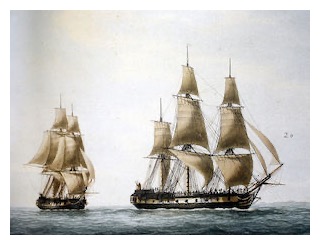
In 1791, Dechampes left for Oceania as a naturalist aboard the frigate, La Recherche, under the command of Rear-Admiral Antoine Reymond Joseph de Bruny d’Entrecasteaux (1737-1793). Their mission was to find traces of two missing French ships from an research expedition that had been under the command of Jean-François de La Pérouse (1741-1788). Unfortunately, d’Entrecasteaux died of disease at sea off Java in 1793. The crew was also devastated by disease. When rumors of the Reign of Terror in France reached the new commander, a royalist, he diverted the increasingly chaotic voyage to the Dutch colony at Surabaya, where the ship was seized by the Dutch. Still, it was sensible move on the new commander’s part; d’Entrecasteuax’s own brother would be sent to the guillotine in 1794. Besides d’Entecasteaux, 89 other members of the ill-fated ship’s crew eventually died. The ship itself was released back to the French in 1794.
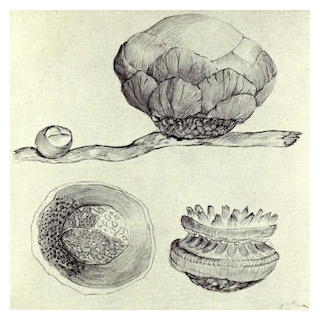
Deschamps survived but, being himself an aristocrat, abandoned what little was left of the mission to botanize for four years on Java at the invitation of the Dutch governor van Overstraten. He remained in Batavia (now Jakarta) to work as a doctor until 1802. While in Java, Deschamps travelled extensively and developed a unique knowledge of the field. He was the first European to observe and record Rafflesia, a genus of very odd holoparasitic flowering plants. A number of others, such as the exceedingly rare Aeschynomene trachyloba, which has only been found once more and not recorded since, would have been of great interest to botany. With the dangers of the Reign of Terror long past, Deschamps eventually left for the French island of Mauritius before finally returning to his family home at Saint-Omer in 1803. He would work there as a surgeon at the local hospital until his death.
Unfortunately, the ship carrying him, his notes, papers, drawings and botanical specimens—representing some eleven years of research—was seized in the English Channel in 1803 by the British, then at war with France. Deschamps’ work would be declared war booty and deposited at East India House. Released and finally safely back in France, Deschamps continued to be involved with the world of botany but his greatest achievements would remain unpublished. He had intended to publish his research as a multi-volumed Flora Javanica. A small part of his work was filtered back to him at the intercession of Sir Joseph Banks. Another important part would turn up much later at a clearance sale by East India House (vacated in 1860, sold, and demolished the next year) to be bought by John Reeves and given to the British Museum in 1861. Deschamps’ dried specimens, however, have been lost.
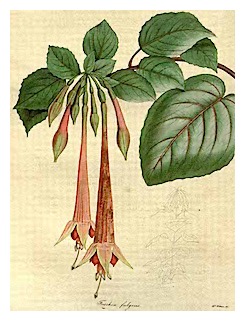
Seemingly undaunted towards the end of his life by his earlier misfortunes, Deschamps is said to have mounted a plant collecting expedition to Mexico in about 1835-1836. The record is still a bit unclear if he personally left for Mexico or simply sent agents who arranged the collecting for him. Logically the latter. By this date, Deschamps would have been a young seventy years old. This time he seems to have concentrated on live plants for sale back in Europe. For example, several crates of cacti freshly acquired from him by a nurserymen in London were advertised for sale in the Gardeners Weekly in 1838. The fashionable Lee & Kennedy Nursery of Hammersmith, which had previously introduced such delights as Fuchsia magellanica and the dahlia to Britain, was to acquire another Mexican plant from Deschamps. It would prove popular with an eager public hungry for novelty: Fuchsia fulgens, or the “brilliant fuchsia”.
Deschampsia, a genus of grasses, was named in his honor by Palisot de Beauvois in 1812. Deschampsia antarctica is one of one only two flowering plants native to the frozen continent.
(Illustrations: 1. La Recherche and a sister ship, Espérance by François-Geoffroi Roux. L’Empire des Mers, 1826; 2. Deschamps’ own 1797 sketch of what would be described as Rafflesia patma twenty-seven years later by Carl Ludwig Blume (1796–1862). The genus was also recorded by Deschamps as Patma, the native Javanese name for the plant. Deschamps’ sketch has been in the British Museum since 1861; 3. Fuchsia fulgens Moç. & Sessé ex DC. B. Maund and J. S. Henslow, The Botanist, 1838, vol. 2, table 63.)
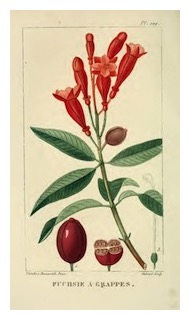
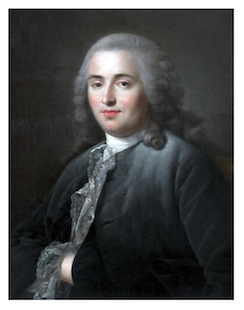
Despite being granted a safe-conduct pass by the leader of the revolution, Toussaint Louverture, Descoutilz's life was in constant danger and he had close brushes with death. He even found himself taken prisoner by rebels but was spared when it was discovered he was a doctor. In spite of the dangerous misadventures, Descourtilz still managed to make a number of significant botanical collections, mostly between Port-au-Prince and Cap-Haïtien, as well as along the Artibonite River.
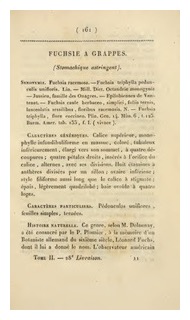
Along with the lengthy botanical description, Descourtilz relays a number of interesting details: That its flowers were used as a dye by natives; that it's easily propagated from suckers, cuttings or seeds; that it should be frequently sprinkled with water when in cultivation; and that its berries are sweet to the taste. One would almost suspect that he had grown the plant himself. There is also a thorough explanation of its medicinal properties. He even gives a recipe for preparing medicine from F. triphylla and how it should be applied. What is perhaps most fascinating in Descourtilz's report is that he observed the plant a number of times at Santiago de Cuba. As F. triphylla is not native to that island, it was evidently in cultivation there at the time.
(Illustration: Fuchsie à grappes, Plate 109 in Descourtilz's Flore pittoresque et médicale des Antilles, ou, Histoire naturelle des plantes usuelles des colonies françaises, anglaises, espagnoles et portugaises, Vol. II, 1822.)
Diagnosis – The description that formally identifies a new species on its publication. Until 2011, a diagnosis was required to be written in Latin to be valid. Since the last International Botanical Congress held in Melbourne, Australia in 2011, however, botanists may now publish a valid diagnosis in English as well as in Latin. See also International Code of Nomenclature for algae, fungi, and plants (ICN).
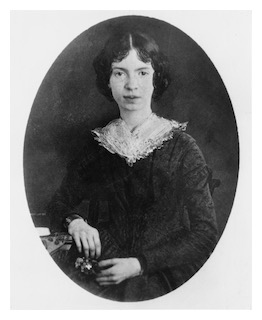
In fact, a small fuchsia slip with two flowers was pressed into her herbarium book of plants collected between 1839 and 1846 and neatly labeled in her hand as “Fuschia [sic], magellanica. 5– 1.” It’s amusing to note that she makes the same common mistake that has foiled more than one spelling bee contestant since Plumier and which many still make today. Surprisingly for one of the most popular and fashionable plants of the period, the fuchsia appears only once among her almost eighteen hundred poems.
I tend my flowers for thee, written in early 1862 as if to an absent lover, features some eight of the inhabitants of her garden and starts off with a striking and evocative image of the opening fuchsia that comes about as close to a floral strip tease as the prim public manners of the age might allow:
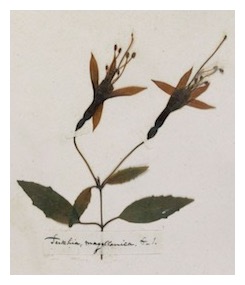
Bright Absentee!
My Fuchsia's Coral Seams
Rip — while the Sower — dreams
➤ I tend my flowers for thee.
(Illustration: F. magellanica from the garden of Emily Dickinson. It shares the page with five other plants on folio 39 of her herbarium, now preserved in the Houghton Library at Harvard University. The whole collection, taken by Dickinson from 1839-1846, contains over five hundred plant specimens all neatly pressed and labeled with their scientific names on the book’s sixty-six pages.)
Dioecious, Dioecism – A dimorphic breeding system in plants in which the species population is divided between individuals that have staminate or male flowers and those that have pistillate or female flowers. Some fuchsias, such as F. encliandra, are dioescious. See also Gynodioecious, Perfect Flowers.
Diploid – Having two sets of chromosomes.
Diporites aspis – Pollen Fossils.
Discolor – Two-colored, of varying colors. F. discolor (Lindl. 1836) is a synonym of F. magellanica (Lam. 1788) ➤ Section Quelusia.
Distal – Remote from the point of attachment or origin. For example, the distal end of a branch. See also Proximal..
Dolicantha – Long flowered. F. dolichantha (E.H.L.Krause 1905) is a synonym of F. confertifolia (Fielding & Gardner 1844) in ➤ Section Fuchsia.
Dominiana – F.× dominiana (auct. 1854) is an invalid species but remains unresolved as a synonym. Fl. [Serres Jard. Eur. 10: 95 1854.]
Dorsal – Referring to the upper surface or top side of a leaf.

A version of the synonym was included in the Encycl. 2: 565 (1788), where reference is made to "Dorvalla eucharis Commers. Herb." under the entry for the Fuchsie de Magellan, Fuchsia magellanica. Commerson's name on his herbarium specimen was never published validly. The spelling Dorvalla as given by Lamarck differs from Hoffmannegg's Dorvalia. Dorvallia is also given in Prodr. [A. P. de Candolle] 3: 36 (1828), nom. inval. Finally, Dorvallia euchomis is Dorvallia Comm. ex Juss. in Gen. Pl. [Jussieu] 320 (1789).
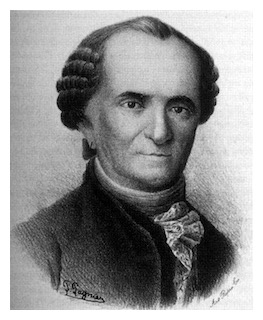
Validly published or not, the Dorvalia, Dorvalla, or Dorvallia genus is still a synonym. It remains to be determined whom Commerson intended to honor with the name
(Illustrations: 1. Johann Centurius Graf von Hoffmansegg. 2. Phillibert Commerson.)
Double Potting – A system in which a smaller pot containing fuchsias is placed inside a larger pot. The space between the two is then filled with an insulating material, such a peat moss. The technique helps protect sensitive fuchsia roots from heat.
Drapkin, Ida (1922-2000) – See Ida Drapkin Fuchsia Garden.
Drench – To soak a pot or roots with water or a solution containing liquid plant food or other chemical treatments.
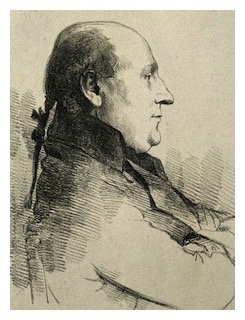
(Illustration: Detail of Jonas Dryander by W. Daniell, 1811 after George Dance, 1795.)
Double – Cultivated fuchsia with eight or more petals to the blossom. In nature, fuchsias have four petals. Some have none. See also ➤ Single, ➤ Semi-Double.
Dunlop, Fuchsia – See ➤ Fuchsia (personal name).
Dwarf Fuchsia – Common name very occasionally applied to F. x bacillaris in ➤ Section Encliandra.





